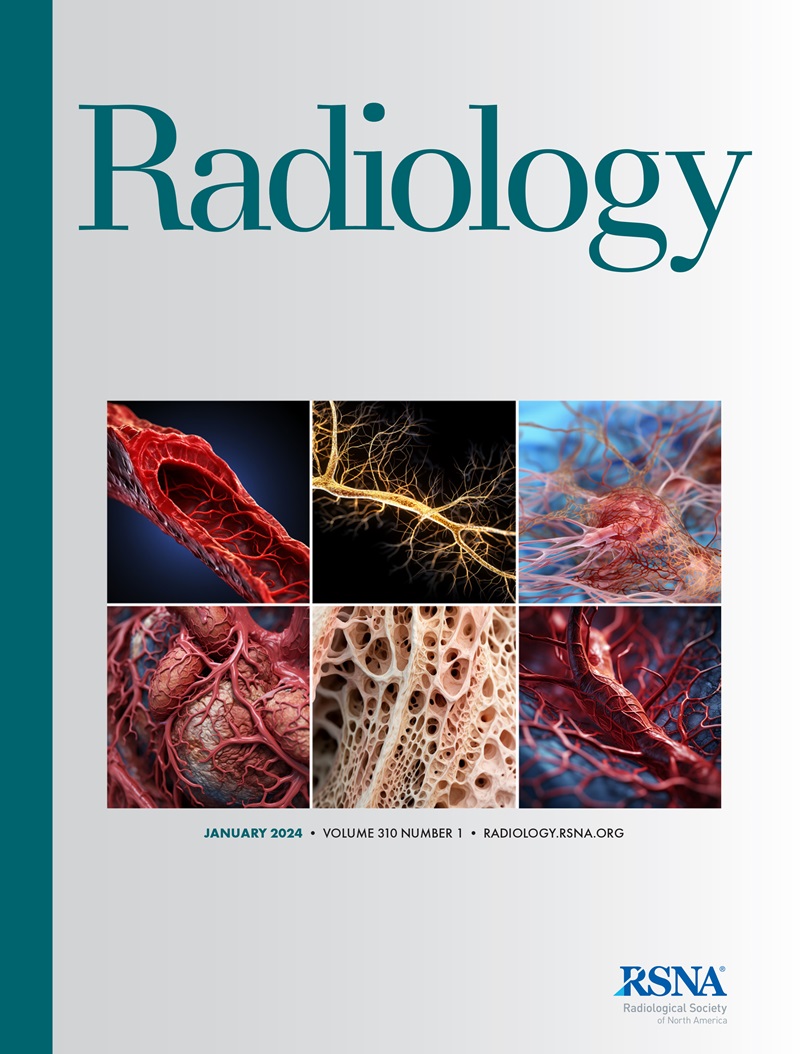浸润性导管癌和小叶癌腋窝淋巴结的淋巴结报告和数据系统评价。
IF 15.2
1区 医学
Q1 RADIOLOGY, NUCLEAR MEDICINE & MEDICAL IMAGING
引用次数: 0
摘要
虽然淋巴结报告和数据系统(Node- rads)提供了一种评估淋巴结转移的标准化方法,但其表现可能因乳腺癌的组织学类型而异。目的探讨node - rads评分在浸润性导管癌(IDC)或浸润性小叶癌(ILC)患者腋窝淋巴结累及的适用性。材料与方法在本回顾性研究中,分析了2017年1月至2018年12月期间连续接受术前乳房MRI检查的病理证实的IDC或ILC女性的数据。采用Node-RADS对腋窝淋巴结状态进行评估,其中淋巴结大小和形态标准合并为最终评估评分,评分范围从1(非常低怀疑)到5(非常高怀疑)。采用χ2检验比较两种组织学类型患者腋窝淋巴结转移的node - rads评分的预测效果。结果共纳入1602例女性(平均年龄50.6岁±9.8 [SD]),其中双侧肿瘤25例,共发生1627例乳腺癌。其中1486例为IDC, 141例为ILC。IDC的淋巴结转移率为25%(1486例中377例),ILC的淋巴结转移率为28%(141例中40例)(P = 0.44)。在预测两种组织学类型的腋窝淋巴结转移时,node - rads评分为3分或更高产生了最高的约登指数。在此截止点,IDC的敏感性和特异性分别为71.1%(377例中268例)和86.5%(1109例中959例),ILC的敏感性和特异性分别为52.5%(40例中21例)和85.1%(101例中86例)。虽然没有证据表明不同组织学类型之间特异性存在差异,但ILC的敏感性明显较低(P = 0.02)。IDC和ILC的受试者工作特征曲线下面积(AUC)分别为0.83和0.74 (P = 0.08)。多变量logistic回归分析证实,node - rads评分是腋窝淋巴结转移的独立预测因子(优势比为3.1;P < 0.001)。结论淋巴结- rads评分在腋窝淋巴结评估IDC和ILC的AUC方面表现相当,但对ILC的敏感性较低。©RSNA, 2025本文可获得补充材料。参见Freitas在本期的社论。本文章由计算机程序翻译,如有差异,请以英文原文为准。
Node Reporting and Data System Evaluation of Axillary Nodes in Invasive Ductal and Lobular Carcinoma.
Background Although the Node Reporting and Data System (Node-RADS) offers a standardized method for assessing lymph node metastasis, its performance may vary according to the histologic type of breast cancer. Purpose To evaluate the applicability of the Node-RADS score in assessing axillary lymph node involvement in patients with invasive ductal carcinoma (IDC) or invasive lobular carcinoma (ILC). Materials and Methods In this retrospective study, data from consecutive women with pathologically confirmed IDC or ILC who underwent preoperative breast MRI between January 2017 and December 2018 were analyzed. Axillary nodal status was assessed using Node-RADS, in which nodal size and configuration criteria are combined into a final assessment score ranging from 1 (very low suspicion) to 5 (very high suspicion). The performance of the Node-RADS score for predicting axillary lymph node metastasis was compared between the two histologic types using the χ2 test. Results A total of 1602 women (mean age, 50.6 years ± 9.8 [SD]), including 25 with bilateral cancers, were included, yielding 1627 breast cancers. Among these cancers, 1486 were IDC and 141 were ILC. The frequency of lymph node metastasis was 25% (377 of 1486) for IDC and 28% (40 of 141) for ILC (P = .44). A Node-RADS score of 3 or greater yielded the highest Youden index for predicting axillary lymph node metastasis for both histologic types. At this cutoff, the sensitivity and specificity were 71.1% (268 of 377) and 86.5% (959 of 1109) for IDC and 52.5% (21 of 40) and 85.1% (86 of 101) for ILC, respectively. Although there was no evidence of a difference in specificity between the histologic types, sensitivity was significantly lower for ILC (P = .02). The area under the receiver operating characteristic curve (AUC) was 0.83 for IDC and 0.74 for ILC (P = .08). Multivariable logistic regression analyses confirmed Node-RADS score as an independent predictor of axillary lymph node metastasis (odds ratio, 3.1; P < .001). Conclusion The Node-RADS score demonstrated comparable performance in terms of AUC in axillary nodal evaluation for IDC and ILC but lower sensitivity for ILC. © RSNA, 2025 Supplemental material is available for this article. See also the editorial by Freitas in this issue.
求助全文
通过发布文献求助,成功后即可免费获取论文全文。
去求助
来源期刊

Radiology
医学-核医学
CiteScore
35.20
自引率
3.00%
发文量
596
审稿时长
3.6 months
期刊介绍:
Published regularly since 1923 by the Radiological Society of North America (RSNA), Radiology has long been recognized as the authoritative reference for the most current, clinically relevant and highest quality research in the field of radiology. Each month the journal publishes approximately 240 pages of peer-reviewed original research, authoritative reviews, well-balanced commentary on significant articles, and expert opinion on new techniques and technologies.
Radiology publishes cutting edge and impactful imaging research articles in radiology and medical imaging in order to help improve human health.
 求助内容:
求助内容: 应助结果提醒方式:
应助结果提醒方式:


